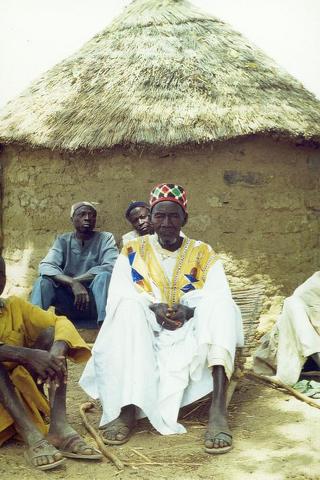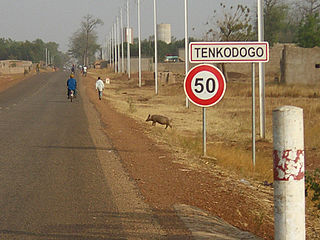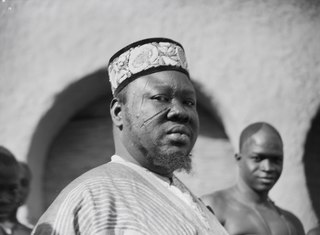Related Research Articles

Ouagadougou or Wagadugu is the capital of Burkina Faso, and the administrative, communications, cultural and economic centre of the nation. It is also the country's largest city, with a population of 2,415,266 in 2019. The city's name is often shortened to Ouaga. The inhabitants are called ouagalais. The spelling of the name Ouagadougou is derived from the French orthography common in former French African colonies.

Jean-Baptiste Philippe Ouédraogo, also referred to by his initials JBO, is a Burkinabé physician and retired military officer who served as President of Upper Volta from 8 November 1982 to 4 August 1983. He has since mediated a few national political disputes and operates a clinic in Somgandé.

The music of Burkina Faso includes the folk music of 60 different ethnic groups. The Mossi people, centrally located around the capital, Ouagadougou, account for 40% of the population while, to the south, Gurunsi, Gurma, Dagaaba and Lobi populations, speaking Gur languages closely related to the Mossi language, extend into the coastal states. In the north and east the Fulani of the Sahel preponderate, while in the south and west the Mande languages are common; Samo, Bissa, Bobo, Senufo and Marka. Burkinabé traditional music has continued to thrive and musical output remains quite diverse. Popular music is mostly in French: Burkina Faso has yet to produce a major pan-African success.

The Mossi are a Gur ethnic group native to modern Burkina Faso, primarily the Volta River basin. The Mossi are the largest ethnic group in Burkina Faso, constituting 52% of the population, or about 11.1 million people. The other 48% of Burkina Faso's population is composed of more than 60 ethnic groups, mainly the Gurunsi, Senufo, Lobi, Bobo, Bissa and Fulani. The Mossi speak the Mòoré language.

Yatenga is one of the provinces of Burkina Faso, located in the Nord Region of the country. In modern Yatenga, the most prominent city is Ouahigouya. This city served as the capital of the kingdom of Yatenga, a powerful kingdom out of the many Mossi kingdoms, but its influence decreased in the century following French colonisation. The city is famed today for being home to the Naba's compound and the tomb of Naba Kango.

Tenkodogo is the capital city of Boulgou Province and the Centre-Est Region of Burkina Faso with a population of 61,936 (2019). Tenkodogo is also the capital of the Tenkodogo Mossi Kingdom and considered to be root of all other Mossi Kingdoms, having been found circa 1100. The literal translation of Tenkodogo is ancient-land.

The Mossi Kingdoms, sometimes referred to as the Mossi Empire, were a group of powerful kingdoms in modern-day Burkina Faso which dominated the region of the upper Volta river for hundreds of years. The largest Mossi kingdoms was that of Ouagadougou and the king of Ouagadougou known as the Mogho Naaba, or King of All the World, serves as the Emperor of all the Mossi. The first kingdom was founded when Dagomba warriors from the region that is present-day Ghana and Mandé warriors moved into the area and intermarried with local people. Centralization of the political and military powers of the kingdoms begin in the 13th century and led to conflicts between the Mossi kingdoms and many of the other powerful states in the region. In 1896, the French took over the kingdoms and created the French Upper Volta which largely used the Mossi administrative structure for many decades in governing the colony.

Naaba Koom II (1889–1942) was emperor of the Mossi state of Wogodogo in French West Africa from 27 February 1905 to his death on 12 March 1942. He succeeded 11 days upon the death of Naaba Sigiri in 1905. He was succeeded by Naaba Saaga II.
Articles related to Burkina Faso include:
Naba may refer to:

Wobogo was the Mogho Naba (ruler) of Ouagadougou from 1890 to 1897, at the time of the French colonial conquest of Upper Volta. Wobogu was originally called Boukary Koutou, but dropped those names on his accession and assumed the name "Wobogu", meaning elephant.
Guiba or Djiba is a village in Burkina Faso. It is famous for being the traditional place where Mossi crown princes lived before they became Moro Naba (king).
Rawa (Ra-wa) was the developer of the government of Mossi. He was titled one of the masters of war for his accomplishments as a conqueror. A son of Ouedraogo, he is one of the three siblings of the founders of the Mossi and the first citizens of Mossi. While his younger brother, Zoungrana, overlooked the city of Tenkodogo, and his other brother, Diaba Lompo, headed south and founded Gurmanche, Rawa traveled north to establish the city of Zandana.
Ouédraogo was the son of Yennenga and progenitor of the Mossi Kingdoms. He founded the kingdom of Tenkodogo. His three sons were Rawa, Diaba Lompo, and Zoungourana.
Zoungrana, was a Mossi ruler, either the first or second ruler of Tenkodogo. He was the third son of Ouedraogo.
Naba Baongo II is the current Mogho Naba, the constituent king of the Mossi people of Burkina Faso. According to oral tradition, he is the 37th king of the Mossi. As king, he is seen as a symbol of tradition and still retains influence in political matters within the country, and elected MPs, ministers, and ambassadors are known to seek his approval.
Naba Kougri was, according to the traditional order, the 36th Mogho Naba of Ouagadougou, the king of the Mossi people of Burkina Faso. He was the son of the previous Mogho Naba, Sagha II. He reigned from 1957 to his death on 8 December 1982.
Naaba Kango or Naba Kango is known as the greatest of the rulers of Yatenga, an early modern kingdom in present-day Burkina Faso.
On 4 August 1983, a coup d'état was launched in the Republic of Upper Volta in an event sometimes referred to as the August revolution or Burkinabé revolution. It was carried out by radical elements of the army led by Thomas Sankara and Blaise Compaoré, against the regime of Major Jean-Baptiste Ouédraogo. Ouédraogo had been brought to power in a 1982 coup with the Conseil de Salut du Peuple (CSP), a body composed of military officials of different ideological backgrounds. The CSP chose Sankara as Prime Minister of Upper Volta in January 1983. As his tenure progressed, Ouédraogo found himself unable to reconcile the conservative and radical factions of the CSP, whose disagreements were leading to a political stalemate. On 16 May he purged his government of pro-Libyan and anti-French elements, disbanded the CSP, and had Sankara and several other important officials arrested. This move sparked discontent among Sankara's supporters. Sankara was eventually released while one officer, Compaoré, began to organise military resistance to the government.
References
- ↑ Englebert 1996, p. 11.
- ↑ Belsour, Camille (2015-09-23). "Qui est le Mogho Naaba, au centre des négociations au Burkina Faso?". SlateAfrique (in French). Retrieved 2018-05-16.
- ↑ Levtzion 1975, pp. 186–187.
- ↑ Ouedraogo 2000, p. 73–74.
- ↑ Englebert 1996, pp. 13–14.
- 1 2 3 4 5 6 7 8 9 10 11 12 13 14 15 16 17 18 19 20 21 22 23 24 25 26 27 28 29 30 31 32 33 34 35 36 37 38 Tiendrebeogo, Yamba (1963). "Histoire traditionnelle des Mossi de Ouagadougou". Journal de la Société des Africanistes (in French). 33 (1): 7–46. doi:10.3406/jafr.1963.1365.
- ↑ Rupley, Bangali & Diamitani 2013, pp. 155–156.
- 1 2 Rupley, Bangali & Diamitani 2013, p. 156.
- ↑ Levtzion 1975, p. 186.
- ↑ Rupley, Bangali & Diamitani 2013, p. 150.
- 1 2 3 4 5 6 7 8 9 10 Stewart, John (2006). African States and Rulers (Third ed.). Jefferson: McFarland & Company, Inc. p. 233. ISBN 0-7864-2562-8.
- 1 2 Rupley, Bangali & Diamitani 2013, p. 23.
- ↑ Ainsi on a assassiné tous les mosse, p 83, 84, 85
- ↑ Mahamadou Ouédraogo, Culture et développement en Afrique p 73-75
- ↑ Lassina Simporé, « La métallurgie traditionnelle du fer et la fondation du royaume de Wogdogo» dans Crossroads / Carrefour Sahel: Cultural and technological developments in first millennium BC/AD West Africa, Africa Magna Verlag, 2009, p.251, note 3